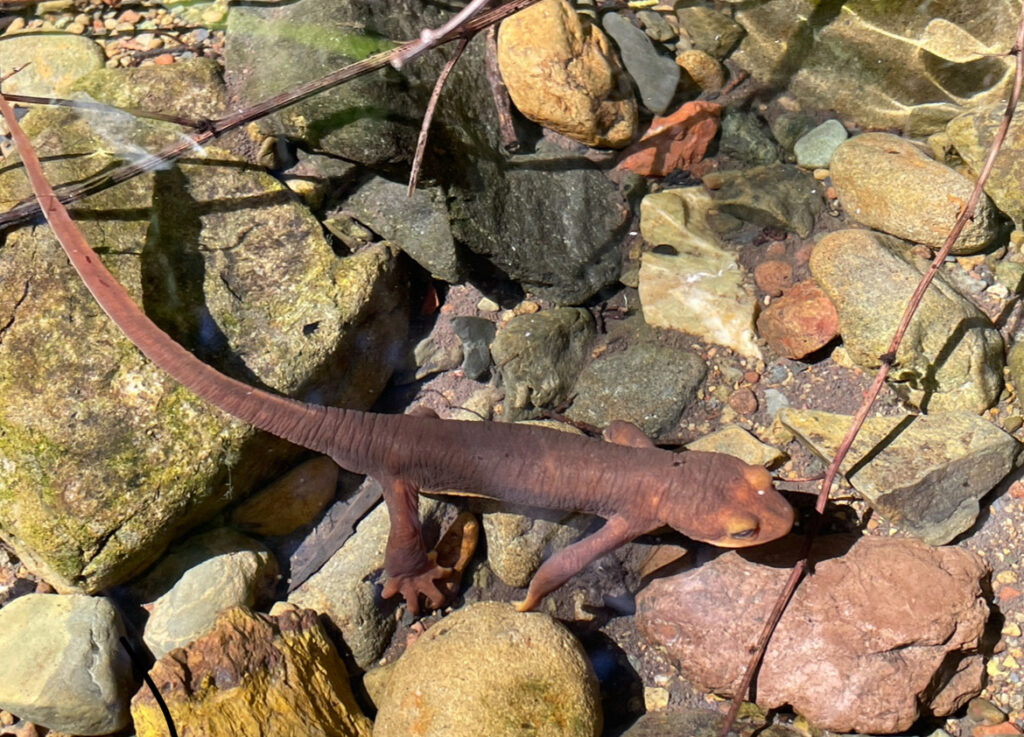News
Don’t Mess With Newt!
April 9, 2024

Don’t mess with Newt!
Say hello to the California newt (Taricha torosa), a local celebrity. You may have seen them bumbling along the forest floor during the rainy season. These newts range from San Diego up to Mendocino County.
With their clumsy gait and cute, doleful eyes, you would think they are just another harmless and quirky addition to California’s fauna. But watch out! They are actually one of the deadliest animals in the world. California newts contain high amounts of tetrodotoxin throughout their bodies.
Tetrodotoxin is an incredibly potent neurotoxin that can kill an adult human if even a fraction of an ounce is ingested. According to reptile scientist Dr. Gary Bucciarelli of the University of California Davis, “Taricha newts should not be handled unless by knowledgeable personnel, because they can contain up to 54 milligrams of tetrodotoxin per individual. Doses up to 42 micrograms per kilo of body weight can lead to hospitalization or death.” Bucciarelli made the remarks in a November, 2023 article in www.phys.org.
In 1979, a 29-year-old man died after taking a bet and swallowing a California newt. But most websites report that you won’t fall gravely ill from quickly moving a newt out of the way and then immediately washing your hands. Still, it’s best to err on the side of caution and avoid contact or carry your handy-dandy disposable plastic gloves!
Why would cute-newt resort to so much overkill? It’s because one of their few predators — the California garter snake – is resistant to tetrodotoxin. This is an example of how nature stages an arms race, where predators and prey species evolve specific adaptations over time in response to one another. In this case, the newts have evolved to be unbelievably toxic while the garter snakes have evolved to find them unbelievably delicious.
Now you may think: “Well … how does being more deadly than cyanide help when you’re already being eaten?” And that’s a fair point because it actually doesn’t. What it does do is take down the predator with you, assuring your remaining newt friends and family won’t meet a similar fate at the hands of that particular snake or peckish raccoon.
And this does not mean that the newts go impassively and quietly into the night. Their main defense warning is to arch back their heads and tails in a sort of silly yoga pose, exposing their bright orange underbelly. This is the newt’s color-coded roadway-hazard warning to potential predators. Things that are bright and visible in nature are usually colorful for a reason. In this case it’s not about mating, it’s about toxicity.
These newts have also been known to flip on their back with the drama of a Shakespearean actor to convey that same message. Quite a curtain call when your back is against the wall.
When they aren’t polishing off anything foolish enough to lay their lips on them, the California newt is either eating, mating or hibernating until the next rainy season. A classic springtime scene in forest puddles is a “newt ball,” a cartoonishly large dogpile of male newts all wrestling for the chance to mate with the female who is usually at the center. So, they do romantic comedy, too!
Newts can be very active on rainy evenings. Please be careful to avoid them if they’re crossing roads!
And don’t eat them.